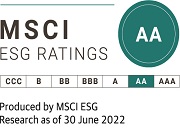Document Library
| Factsheet | KIID |
| Interim report | Annual report |
| Holdings report | Monthly note |
| Quarterly note | Prospectus |
| Assessment of value |
For additional fund documents and share classes visit our literature library
Awards and Ratings
 |
 |
 |
 |
Why invest in the Rathbone Strategic Bond Fund?
- Exposure to the whole global fixed income market, with limited currency risks
- A blend of areas with more risk and reward, such as high yield and emerging markets, and safer assets such as government and high-quality corporate bonds
- The managers aim to beat the IA Sterling Strategic Bond sector with lower-than-average volatility
- Identifying big, long-term themes about new technologies, consumer trends or macroeconomic changes and investing accordingly
We buy bonds issued by companies, governments and non-governmental organisations all over the world. The objective of our fund is to deliver a greater total return than the IA Sterling Strategic Bond sector, after fees, over any rolling five-year period. We aim to deliver this return with a lower volatility than the IA Sterling Strategic Bond sector. There is no guarantee that this investment objective will be achieved over five years, or any other time period. We use the IA sector as a target for our fund’s return because we aim to achieve a better return than the average of funds that are similar to ours. We aim to limit the amount of volatility risk our fund can take because we want our investors to understand the risk they are taking compared to funds similar to ours. You can find our fund’s full objective and investment policy in our Key Investor Information Document (KIID).
When picking corporate bonds, there are three assessments we make. First, we look at the economic environment to determine which industries we want to own and the duration, or sensitivity to interest rate changes, of our investments. Then we use the Four Cs Plus approach to evaluate creditworthiness. We assess:
- Character: Whether a company's managers have integrity and competence
- Capacity: Ensuring a company isn't over-borrowing and has the cash to pay its debts
- Collateral: Are there assets backing the loan, which reduces the risk of a loan?
- Covenants: These loan agreements set out the terms of the bond and restrictions on the company
- The Plus: We think differently to the market; sometimes contrarian, sometimes sceptical of orthodox thinking, but always opinionated
Click here for the latest assessment of our performance.
MiFID II charges
I class
Ongoing charges figure (OCF) as at 30.06.2023
0.64%
Transaction costs
0.08%
Total MiFID II charges
0.72%
The MiFID II charges include the Ongoing Charges Figure (OCF) and transaction costs.
Rathbone Strategic Bond Fund Key investor Information document (I class)
16 February 2024
Download FileRathbones Asset Management Assessment of Value 2023 Report (Consolidated)
30 January 2024
Download FileMeet the fund manager

BRYN JONES
Head of fixed income and fund manager
BRYN JONES
Head of fixed income and fund manager
Bryn is head of fixed income at Rathbones and is lead manager of the Rathbone Ethical Bond, the Rathbone Strategic Bond and the Rathbone Greenbank Global Sustainable Bond funds. He joined Rathbones in November 2004 from Merrill Lynch Investment Managers, where he managed $2 billion of fixed income assets. Bryn is a member of the Rathbone Strategic Asset Allocation Committee, non-executive chairman of Rathbones' Fixed Income Committee, and an adviser to the Rathbones Banking Committee. He also sits on the Investment Association’s Fixed Income Committee. Bryn appears regularly on CNBC and Bloomberg TV to discuss bond markets. Bryn graduated from Birmingham University with a Bachelor of Arts degree in Geography in 1995.
Bryn is head of fixed income at Rathbones and is lead manager of the Rathbone Ethical Bond, the Rathbone Strategic Bond and the Rathbone Greenbank Global Sustainable Bond funds. He joined Rathbones in November 2004 from Merrill Lynch Investment Managers, where he managed $2 billion of fixed income assets. Bryn is a member of the Rathbone Strategic Asset Allocation Committee, non-executive chairman of Rathbones' Fixed Income Committee, and an adviser to the Rathbones Banking Committee. He also sits on the Investment Association’s Fixed Income Committee. Bryn appears regularly on CNBC and Bloomberg TV to discuss bond markets. Bryn graduated from Birmingham University with a Bachelor of Arts degree in Geography in 1995.

